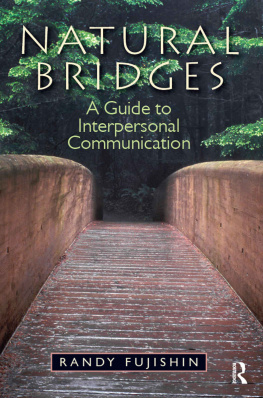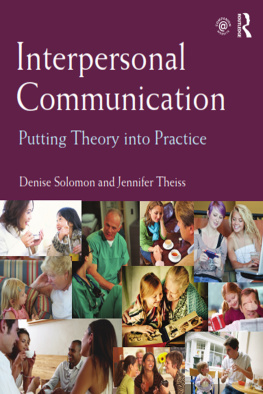Randy Fujishin taught speech communication at West Valley College and is currently a clinical therapist for business executives and pastors. He is the author of Gifts from the Heart, Creating Effective Groups, and Discovering the Leader Within.
The highest art we create is the way we live each day.
BALINESE SAYING
It was just another class assignment for Karen, but it changed her life.
The first homework assignment I give my communication students is to be more spaciousmore accepting and nonjudgmentalin their conversational listening. I coach them to punctuate their daily conversations with periods of silence as they listen to others. Rather than verbally interrupt a speaker with judgment, advice, encouragement, or questions every twelve seconds, which seems to be the norm for my students, they are to listen without any interruptions for thirty seconds or more, whatever students feel is appropriate for the speaker, the topic, and the flow of the discussion.
I thought this assignment would be boringto listen so long without saying anything, Karen began. But I tried it out on my mom last night and it was wonderful! I would normally interrupt her after a few seconds, give my opinion, and then just walk away.
But last night was different! I let her talk for longer periods of time without interrupting, just like we practiced in class. At times, I kept quiet for thirty seconds, and one or two minutes at other times. Sometimes even longer. It was so weird. But she really opened up during our talk. In fact, she talked about things Ive never heard beforeabout Dad, her job, and how she feels about me.
So, your mom said things she normally wouldnt tell you? I asked.
I think shes always wanted to say these things, but I was the one who wasnt listening, Karen admitted. This assignment forced me to pay attention to her for a change. I feel liked Ive created a whole new relationship with her.
What a wonderful creation, I said.
I feel like I made something really important happen.
Almost like an artist, I chuckled.
Yeah, Im getting good at this art of communication! she smiled.
Whether or not you realize it, you are an artist, and your life is the canvas on which you will create your greatest work. Your most important creation will not be a painting, a sculpture, or a book. Rather, it will be the person you become during this lifetime.
Your greatest work will ultimately find its form and structure in the blending of the broad-brush strokes of your family, relationships, career, and education. More important, it will be textured and imbued with the thousands upon thousands of finer, more delicate brush strokes of every word and action you paint each day on the canvas of your life.
It will be these smaller brush stokes during your everyday lifethe way you treat your loved ones, the manner in which you interact with people at school, work, and in your neighborhood, and even the way you greet strangersthat will most significantly determine the kind of person you become.
The art of communication helps you create the atmosphere within which your interactions with others occur. Whether its a quick smile to a stranger, a heartfelt speech at a wedding reception, or a minute of attentive silence when a loved one is speaking, you are creating the masterpiece of your life moment by moment.
Now, you may be saying to yourself that Im no artist or Art is for those who are trained or gifted. But thats not true. We are all creative, often consciously selecting the words, behaviors, circumstances, responses, and attitudes we bring to our communication interactions with the people in our lives.
Every day you talk, listen, and interact with others. Most of the time, you speak, listen, text, or tweet more out of habit than anything else, not even vaguely aware of your role in the communication process. But Im inviting you not only to become more aware and skilled in those fundamental communication skills, but also to become more creative in the ways in which you think, speak, listen, and interact with others, whether its in a face-to-face interaction or with your mobile communications. If you dont, you may be limiting your opportunities to effectively connect with people. You may even be limiting your opportunities to develop as a person.
Author Thomas Moore warns against our reluctance and maybe even our fears of becoming more creative in our everyday lives: When we leave art only to the accomplished painter and the museum, instead of fostering our own artful sensibilities in every aspect of daily life, then our lives lose opportunities for soul. Rather than being unconscious, unconcerned, or disillusioned about how you communicate with others, take up this invitation to practice the art of communication as you interact with others.
Your acceptance, however, to create more effective communication will not necessarily guarantee success in every interaction. Human communication is much too complicated and involved. There are thousands of unconscious nonverbal behaviors involved in even a single conversation and we are usually aware of only a few of them during the course of the conversation.
The same holds true for the verbal dimension of that same conversation. The hundreds of thousands of words in our language and the millions of possible arrangements of those words are equally staggering. There is no possible way we can consciously choose the perfect words and the perfect sentences for every thought and feeling we wish to communicate.
Verbal and nonverbal communications are also governed by habit. It is easier to say hello and smile as we pass others than it is to create a unique and special greeting for each and every person. Effective communication requires that much of our interaction with others be governed by habit. Otherwise, communication would be too dense, clumsy, and overwhelming. Even if we could select the perfect words, sentences, and behaviors to communicate, there is no guarantee that the recipient of the message would interpret the words and the behaviors in the way we intended.
The process of human communication cannot be as intentional and predictable as the brush strokes on canvas or the careful shaping of clay. We cannot control the viewers interpretation when they see our painting or statue. But in communication with others, you can choose to be more aware of, sensitive to, and selective of your words and behaviors. Your decision to consciously participate in the way you speak and listen to others will open the doors to more effective communication. As Karen learned, even one change in her communication behaviorlistening without interruptingcreated more space for her mother to share. This one change created a wonderful change in their relationship. She was introduced to the fact that she can choose to communicate in ways that enhance her interaction with others. Karen was beginning to appreciate the power and impact of the Art of Communication.
Lets begin with an examination of communication itself, for it is communication that enables us to experience our lives and share experiences with others. The late-night talks, the laughter, the gentle touches, the tears, the encouragement, your Facebook page, and the thousands upon thousands of other communication acts all combine to create what you experience as life. Our communication with others is not a little thing. It is life itself.
All the arts we practice are mere apprenticeship. The big art is our life.
M. C. RICHARDS
The importance of communication cannot be overstated. Family therapist Virginia Satir has suggested that once a human being has arrived on this earth, communication is the single most important factor determining what kinds of relationships he makes and what happens to him in the world. Satir continues by stating in no uncertain terms that how he manages his survival, how he develops intimacy, and how he makes sense of his world are largely dependent upon his communication skills.









